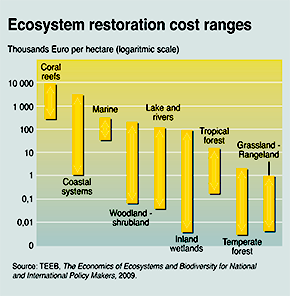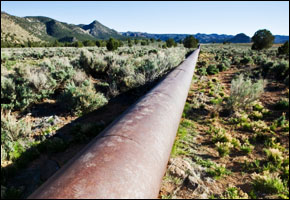Investment in Ecosystem Restoration Brings Water, Land Benefits, UNEP Report Says
Protecting natural capital provides significant benefits at a fraction of the cost of restoring a degraded ecosystems.

According to the report, the cost to restore an ecosystem depends on the type. The graphic shows the different estimated price ranges to restore certain types of ecosystems. Source: TEEB, The Economics of Ecosystems and Biodiversity for National and International Policy Makers, 2009.
The United Nations Environment Programme, in its ongoing effort to quantity the value of nature, released a report yesterday describing the economics of restoration and identifying case studies showing the benefits of such projects to specific communities.
Roughly two-thirds of the planet’s ecosystems are degraded, according to the report Dead Planet, Living Planet, an outcome that has seriously affected water quality, food production, health and human livelihoods.
The services an ecosystem provides are commonly divided into four categories:
– Provisioning (e.g., food, water, timber)
– Regulating (e.g., maintaining water quality, controlling floods, moderating the climate)
– Supporting (e.g., photosynthesis, pollination, soil formation)
– Cultural (e.g., aesthetic quality, recreation, spiritual devotion)
Valuation of these benefits is difficult and inexact, but experts hope that better valuation will help governments make better development decisions. The report estimates that a well-managed restoration project can provide economic returns of 7 to 79 percent.
“Restoration pays off,” said Christian Nellemann of UNEP’s GRID-Arendal in Norway and the report’s chief editor. “Wetlands and forests can be up to 22 times more effective than investing in water treatment plants.”
The report highlighted 36 restoration success stories from a variety of ecosystems and countries. Of particular importance for water resources are forests and wetlands. One-third of the world’s 100 largest cities–including Jakarta, Rio de Janeiro, New York City and Tokyo–draw water from protected forests and 75 percent of freshwater supplies come from forested catchments.
New York City spent $US1 billion restoring watersheds in the Catskill mountains–a significant savings compared to the $US8 billion to build a water filtration plant and $US300 to $US500 million per year to maintain it.
Restoration attempts, however, can be undermined in several ways, the report states:
- Goals may be unrealistic or incompatible
- Improper restoration may lead to habitat monocultures
- Invasive species may unwittingly be transplanted
- Projects may lack monitoring to ensure compliance
- Projects may fail to reduce human impact on the land
- Planners may fail to include local stakeholders in discussions
“Do it right,” Nellemann added, addressing implementation. “Back it up with long term management and, where needed, ensure laws are enforced. You will succeed with broad public support and generate immediate and long term returns.”
Even though restoration provides benefits, it is exponentially more costly than simply protecting the ecosystem in the first place. The annual costs for conserving habitats range from a few pennies to a thousand US dollars per hectare.
Restoration, on the other hand, can cost up to several hundred thousand US dollars per year, according to the report.
Source: UNEP
Brett writes about agriculture, energy, infrastructure, and the politics and economics of water in the United States. He also writes the Federal Water Tap, Circle of Blue’s weekly digest of U.S. government water news. He is the winner of two Society of Environmental Journalists reporting awards, one of the top honors in American environmental journalism: first place for explanatory reporting for a series on septic system pollution in the United States(2016) and third place for beat reporting in a small market (2014). He received the Sierra Club’s Distinguished Service Award in 2018. Brett lives in Seattle, where he hikes the mountains and bakes pies. Contact Brett Walton










Leave a Reply
Want to join the discussion?Feel free to contribute!